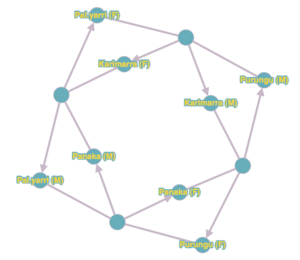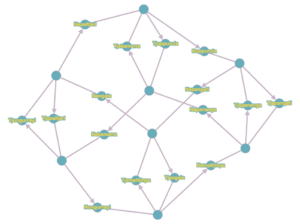Australian Aboriginal kinship facts for kids
Aboriginal Australian kinship describes the special rules and systems that guide how Aboriginal people interact with each other. These rules are a very important part of traditional Aboriginal cultures all across Australia. They are especially important for marriages between Aboriginal people.
The Subsection System (Skins)
A unique part of Aboriginal society is the "subsection system." This system divides everyone into different groups. These groups are often called "skins" in Central Australia. Each skin group has a special name. This name can be used to refer to anyone in that group. Your skin name is passed down to you from your parents.
The number of these groups can be different. Some systems have two main groups, called 'moieties'. Others have four groups (sections), six, or even eight groups (subsection systems). Some groups, like the Pintupi and Warlpiri, have different skin names for males and females, making a total of sixteen names.
Even if people are not blood relatives, they are still given a skin name. This means the system includes everyone in the society. Subsection systems are found across Central, Western, and Northern Australia. Experts believe this social system might have started in the Daly River region of the Northern Territory. From there, it spread quickly to other groups.
Systems with Two Groupings (Moieties)
Some Aboriginal groups divide their society into two main parts, called moieties.
Yolŋu
The Yolŋu people live in north-eastern Arnhem Land. They divide their society, and even parts of the natural world, into two moieties: Dhuwa and Yirritja. Many different groups belong to each moiety. These groups have their own lands, languages, and beliefs. So, many things are either Yirritja or Dhuwa.
| Skin name | Clan groups |
|---|---|
| Yirritja | Gumatj, Gupapuyngu, Wangurri, Ritharrngu, Mangalili, Munyuku, Madarrpa, Warramiri, Dhalwangu, Liyalanmirri. |
| Dhuwa | Rirratjingu, Galpu, Djambarrpuyngu, Golumala, Marrakulu, Marrangu, Djapu, Datiwuy, Ngaymil, Djarrwark. |
Things like fish, stone, rivers, and the sea belong to one moiety or the other. Things that are not Dhuwa or Yirritja are called wakinŋu. The Yolŋu also have a kinship system with eight subsections. These eight subsections are split between the Dhuwa and Yirritja moieties.
Systems with Four Sections
Many Aboriginal groups use a four-section system.
Gamilaraay
The Gamilaraay language group from New South Wales has a four-section system.
| Moiety | Section name (female) | Marries (male) | Children |
|---|---|---|---|
| Wudhurruu | Gabudhaa | Yibaay | Marrii, Maadhaa |
| Maadhaa | Gambuu | Gabii, Gabudhaa | |
| Yangu(r)u | Buudhaa | Marrii | Yibaay, Yibadhaa |
| Yibadhaa | Gabii | Gambu, Buudhaa |
Martuthunira
The Martuthunira language group is from the Pilbara region of Western Australia. They also have a four-section system.
| Section name (female) | Marries (male) | Children |
|---|---|---|
| Karimarra | Panaka | Pal.yarri |
| Panaka | Karimarra | Purungu |
| Pal.yarri | Purungu | Karimarra |
| Purungu | Pal.yarri | Panaka |
Similar systems are found in most language groups in the Pilbara. The names might be a bit different. For example, Ngarla speakers use Milangka where Martuthunira use Pal.yarri.
Alyawarra
The Alyawarre language group from Central Australia also has a four-section system. However, they use different terms than the Martuthunira.
| Section name (female) | Marries (male) | Children |
|---|---|---|
| Kngwarriya | Upurla | Kimarra |
| Upurla | Kngwarriya | Pitjarra |
| Pitjarra | Kimarra | Upurla |
| Kimarra | Pitjarra | Kngwarriya |
Systems with Eight Groups (Subsection Systems)
Some groups have even more detailed systems with eight subsections.
Lardil
The Lardil people live on Mornington Island in the Gulf of Carpentaria. They have eight subsection groups. Each group is linked to certain animals or natural things, called totems.
| Subsection group | Totems | May marry only subsection group |
Children will be |
|---|---|---|---|
| Balyarriny | Black tiger shark, sea turtle |
Kamarrangi | Buranyi |
| Bangariny | Brown shark, turtle | Yakimarr | Ngarrijbalangi |
| Buranyi | Crane, salt water, sleeping turtle |
Kangal | Balyarriny |
| Burrarangi | Lightning, rough sea, black dingo |
Ngarrijbalangi | Kamarrangi |
| Kamarrangi | Rock, pelican, brolga, red dingo |
Balyarriny | Burrarangi |
| Kangal | Barramundi, grey shark |
Buranyi | Yakimarr |
| Ngarrijbalangi | Rainbird, shooting star, egret |
Burrarangi | Bangariny |
| Yakimarr | Seagull, barramundi, grey shark |
Bangariny | Kangal |
Every Lardil person belongs to one of these groups. A person's grandfather's subsection determines their own. So, a Balyarriny person will have a Balyarriny grandfather. Members of each group can only marry people from one specific other group.
Once you know a person's subsection group, you can figure out their relationship to any other Lardil person. For example, a Ngarrijbalangi is like a 'father' to a Bangariny. They are a 'father-in-law' to a Yakimarr. And they are a 'son' to another Bangariny. This can be a social relationship or a direct family one.
In the Lardil system, male generations cycle between two subsections. For example, a Ngarrijbalangi is father to a Bangariny, and a Bangariny is father to a Ngarrijbalangi. Female generations cycle through four subsections before coming back to the start. This means a woman has the same subsection name as her great-great-grandmother.
Pintupi
The Pintupi people live in the Western Desert. They also have an eight-subsection system. It's a bit more complex because male and female names are different. Male names start with "Tj", and female names start with "N". The Warlpiri system is very similar.
| Gender | Subsection name | First marriage preference |
Children will be |
|---|---|---|---|
| Male | Tjapaltjarri | Nakamarra | Tjungurrayi, Nungurrayi |
| Female | Napaltjarri | Tjakamarra | Tjupurrula, Napurrula |
| Male | Tjapangati | Nampitjinpa | Tjapanangka, Napanangka |
| Female | Napangati | Tjampitjinpa | Tjangala, Nangala |
| Male | Tjakamarra | Napaltjarri | Tjupurrula, Napurrula |
| Female | Nakamarra | Tjapaltjarri | Tjungurrayi, Nungurrayi |
| Male | Tjampitjinpa | Napangati | Tjangala, Nangala |
| Female | Nampitjinpa | Tjapangati | Tjapanangka, Napanangka |
| Male | Tjapanangka | Napurrula | Tjapangati, Napangati |
| Female | Napanangka | Tjupurrula | Tjakamarra, Nakamarra |
| Male | Tjungurrayi | Nangala | Tjapaltjarri, Napaltjarri |
| Female | Nungurrayi | Tjangala | Tjampitjinpa, Nampitjinpa |
| Male | Tjupurrula | Napanangka | Tjakamarra, Nakamarra |
| Female | Napurrula | Tjapanangka | Tjapangati, Napangati |
| Male | Tjangala | Nungurrayi | Tjampitjinpa, Nampitjinpa |
| Female | Nangala | Tjungurrayi | Tjapaltjarri, Napaltjarri |
Kunwinjku
The Kunwinjku people live in Western Arnhem Land. They have a similar system. Male names start with "Na", and female names start with "Ngal".
| Gender | Subsection name | First marriage preference |
Second marriage preference |
First marriage children will be |
Second marriage children will be |
|---|---|---|---|---|---|
| Male | Nabulanj | Ngalwakadj | Ngalkangila | Nabangardi, Ngalbangardi |
Nakodjok, Ngalkodjok |
| Female | Ngalbulanj | Nawakadj | Nakangila | Nawamud, Ngalwamud |
Nawamud, Ngalwamud |
| Male | Nangarridj | Ngalkangila | Ngalwakadj | Nakodjok, Ngalkodjok |
Nabangardi Ngalbangardi |
| Female | Ngalgarridj | Nakangila | Nawakadj | Nakamarrang, Ngalkamarrang |
Nakamarrang, Ngalkamarrang |
| Male | Nakamarrang | Ngalkodjok | Ngalbangardi | Nawakadj, Ngalwakadj |
Nakangila Ngalkangila |
| Female | Ngalkamarrang | Nakodjok | Nabangardi | Nabulanj, Ngalbulanj |
Nabulanj, Ngalbulanj |
| Male | Nawamud | Ngalbangardi | Ngalkodjok | Nakangila, Ngalkangila |
Nawakadj, Ngalwakadj |
| Female | Ngalwamud | Nabangardi | Nakodjok | Nangarridj, Ngalgarridj |
Nangarridj, Ngalgarridj |
| Male | Nawakadj | Ngalbulanj | Ngalgarridj | Nawamud, Ngalwamud |
Nakamarrang, Ngalkamarrang |
| Female | Ngalwakadj | Nabulanj | Nangarridj | Nabangardi, Ngalbangardi |
Nabangardi, Ngalbangardi |
| Male | Nakangila | Ngalgarridj | Ngalbulanj | Nakamarrang, Ngalkammarang |
Nawamud, Ngalwamud |
| Female | Ngalkangila | Nangarridj | Nabulanj | Nakodjok, Ngalkodjok |
Nakodjok, Ngalkodjok |
| Male | Nakodjok | Ngalkamarrang | Ngalwamud | Nabulanj, Ngalbulanj |
Nangarridj, Ngalgarridj |
| Female | Ngalkodjok | Nakamarrang | Nawamud | Nawakadj, Ngalwakadj |
Nawakadj, Ngalwakadj |
| Male | Nabangardi | Ngalwamud | Ngalkamarrang | Nangarridj, Ngalgarridj |
Nabulanj, Ngalbulanj |
| Female | Ngalbangardi | Nawamud | Nakamarrang | Nakangila, Ngalkangila |
Nakangila, Ngalkangila |
Each person has a father's subsection group (patrimoiety) and a mother's subsection group (matrimoiety).
Extension of the System to Non-Relatives
People from outside these groups who spend a lot of time interacting with them might be given a 'skin name'. This name is often based on the people they have met and how they have interacted.
Some Common Kinship Terms in Aboriginal English
Many Aboriginal people use English kinship terms in special ways. These ways come from their traditional Aboriginal languages.
- Aunty and uncle are terms used to show respect for older people. You might use these terms even if you are not related to them.
- Brother and sister can mean your actual siblings. But they can also refer to children of your mother's sister or your father's brother (like a cousin). This is common in many Indigenous languages.
- Cousin-brother and cousin-sister are often used for children of your mother's sister and father's brother.
- Cousin usually means children of your father's sister or your mother's brother. It can also mean any relative from your own generation. This includes someone who shares the same great-grandparent, which is a "second-cousin" in Aboriginal terms.
- In south-east Queensland, daughter can refer to any woman from your great-grandparents' generation. This is because of the way traditional kinship systems cycle through generations.
- Father and mother can include any relative from your parents' generation. This might be uncles, aunts, their cousins, or in-laws.
- Grandfather and grandmother can refer to anyone from your grandparents' generation. Grandfather can also be used for any respected older man, even if you are not related to him.
- Poison refers to a relative you are expected to avoid speaking to or being around. See avoidance speech.
- The term second, or little bit in northern Australia, is used for a distant relative. You use it with a close kinship term. For example, your second father or little bit father is a man from your father's generation who is not closely related. A second mother is a woman from your mother's generation who acts like a mother. She might care for you if something happened to your own parents. This is different from close, near, or true relatives.
- A skin or skin group is a section determined by your parents' skin names. It helps decide who a person can marry.
- Son can refer to any male from the next generation, including nephews. Similarly, daughter can refer to any female from the next generation, including nieces.
See Also



